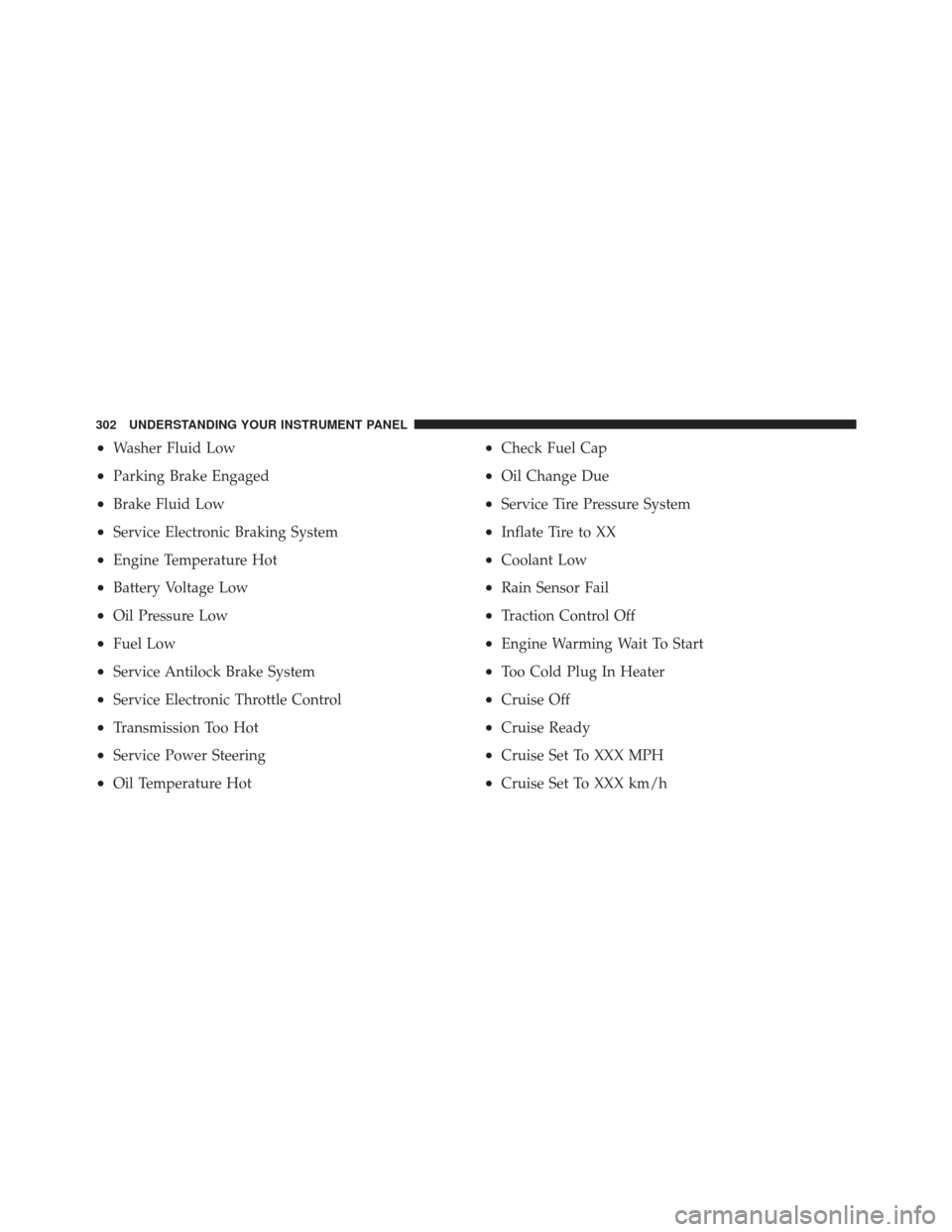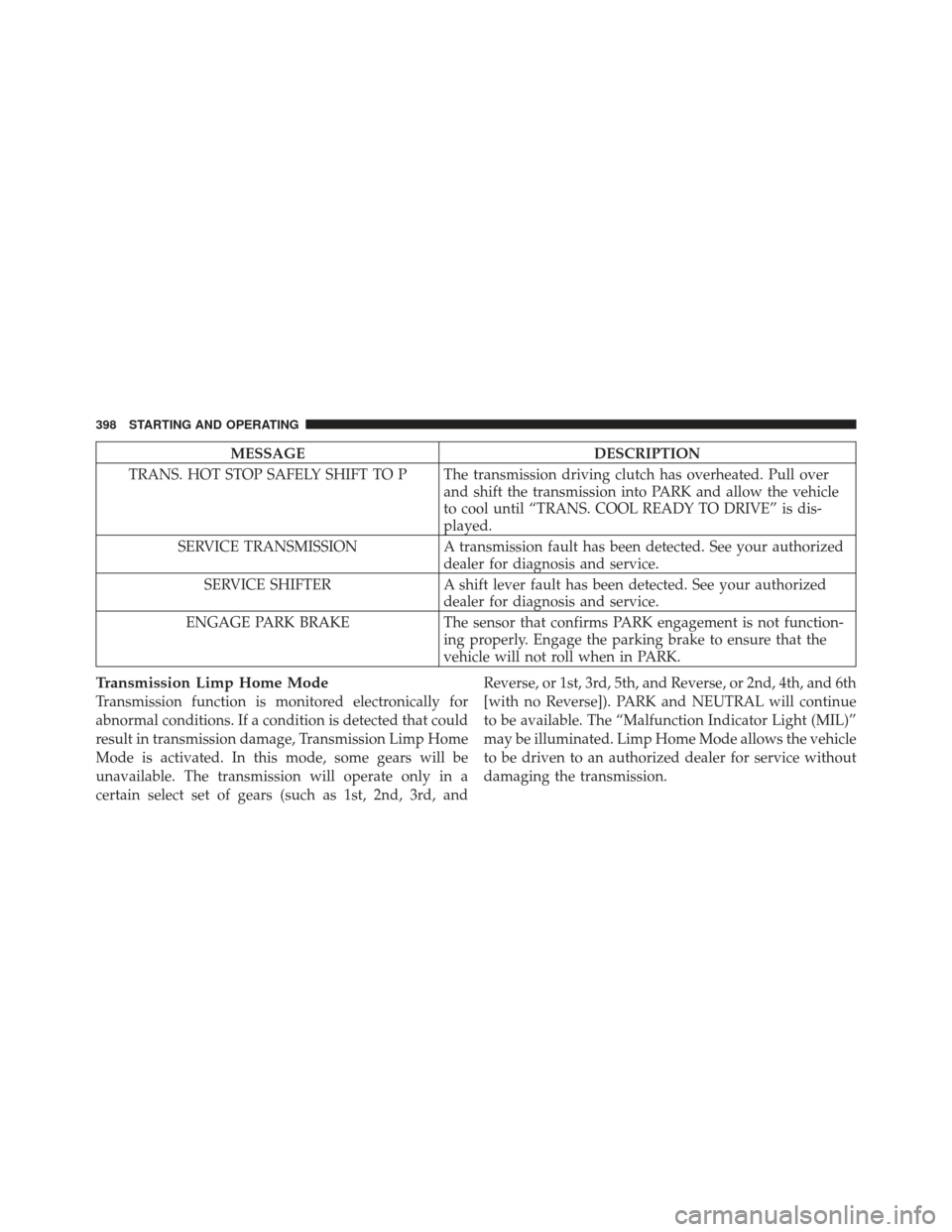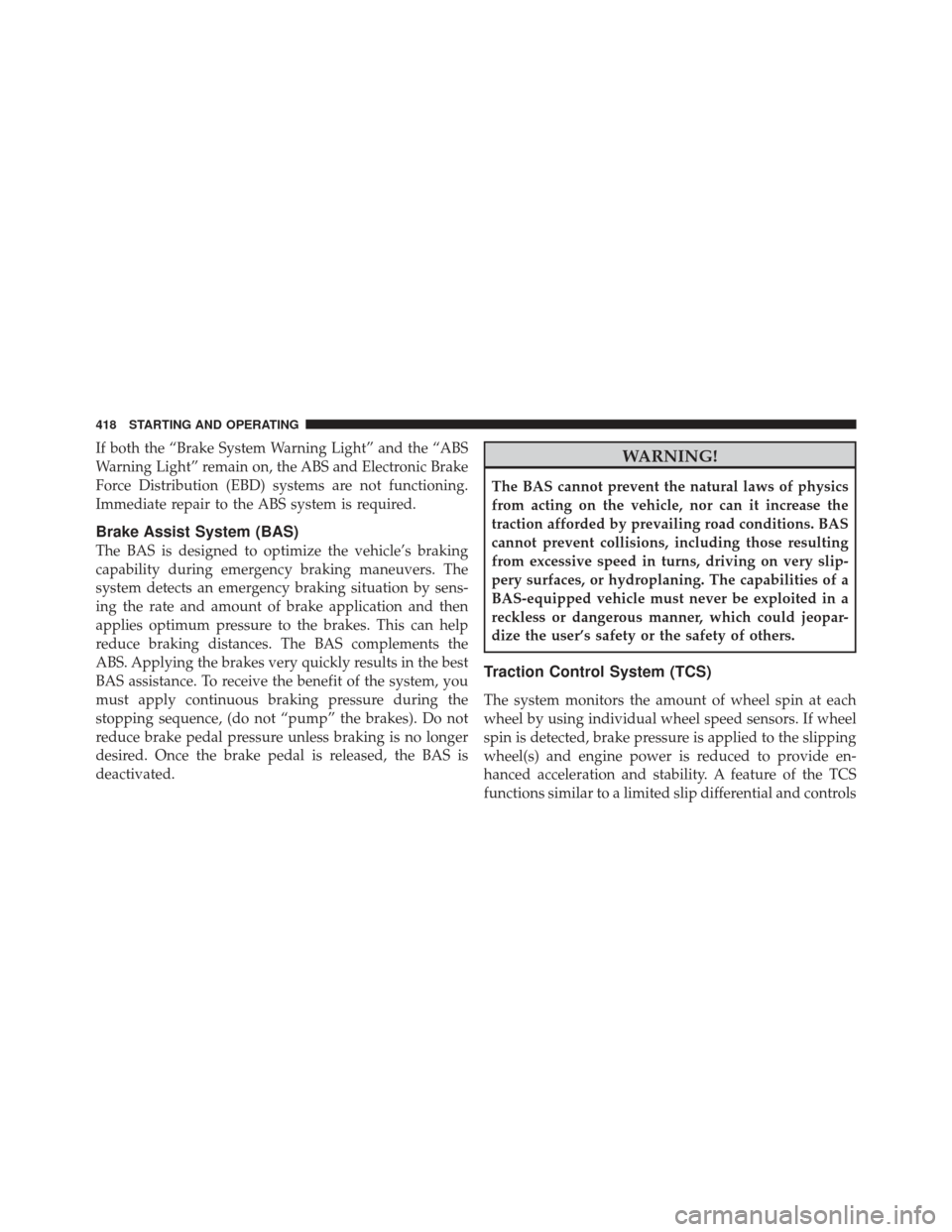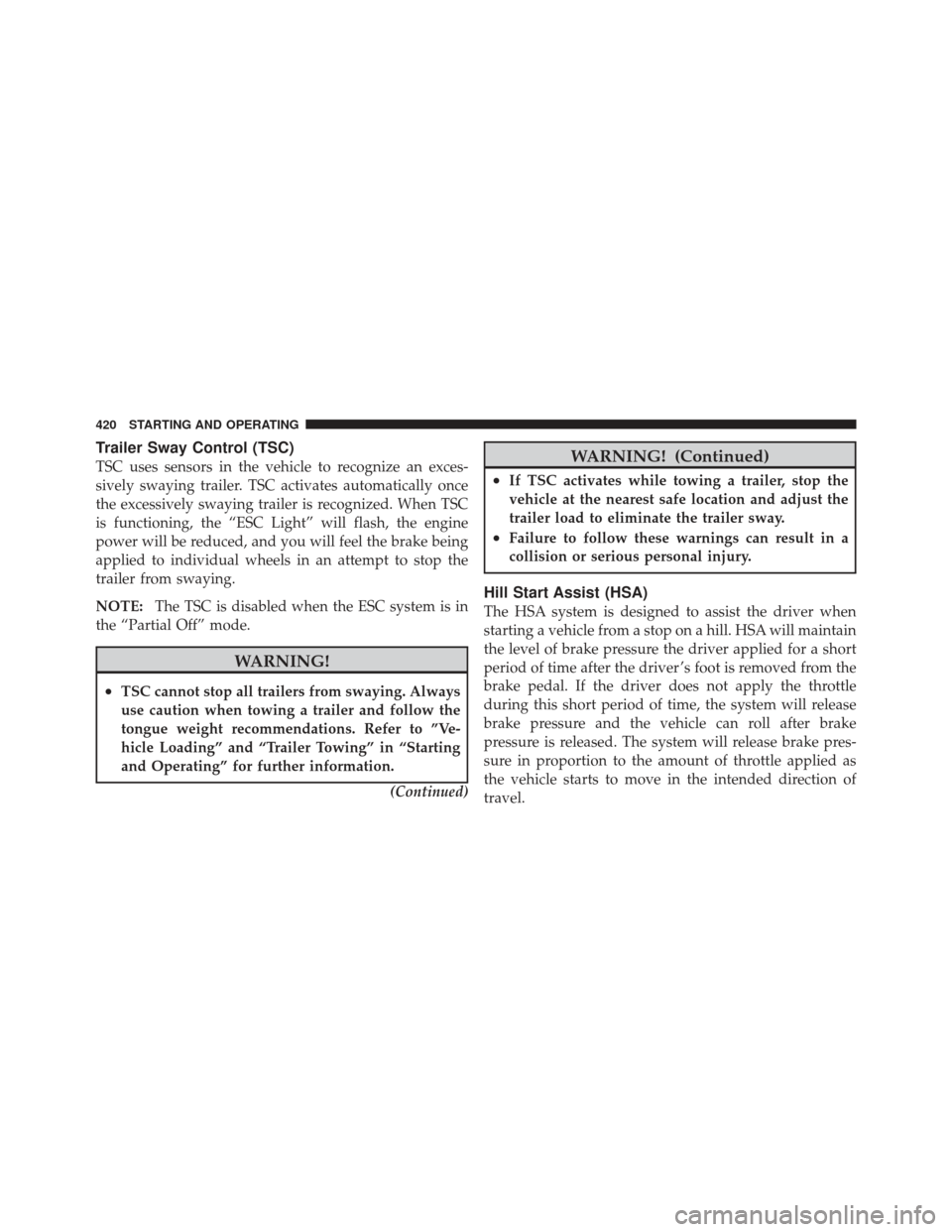brake sensor DODGE DART 2013 PF / 1.G Owners Manual
[x] Cancel search | Manufacturer: DODGE, Model Year: 2013, Model line: DART, Model: DODGE DART 2013 PF / 1.GPages: 604, PDF Size: 4.72 MB
Page 304 of 604

•Washer Fluid Low
•Parking Brake Engaged
•Brake Fluid Low
•Service Electronic Braking System
•Engine Temperature Hot
•Battery Voltage Low
•Oil Pressure Low
•Fuel Low
•Service Antilock Brake System
•Service Electronic Throttle Control
•Transmission Too Hot
•Service Power Steering
•Oil Temperature Hot
•Check Fuel Cap
•Oil Change Due
•Service Tire Pressure System
•Inflate Tire to XX
•Coolant Low
•Rain Sensor Fail
•Traction Control Off
•Engine Warming Wait To Start
•Too Cold Plug In Heater
•Cruise Off
•Cruise Ready
•Cruise Set To XXX MPH
•Cruise Set To XXX km/h
302 UNDERSTANDING YOUR INSTRUMENT PANEL
Page 400 of 604

MESSAGEDESCRIPTION
TRANS. HOT STOP SAFELY SHIFT TO P The transmission driving clutch has overheated. Pull over and shift the transmission into PARK and allow the vehicle
to cool until “TRANS. COOL READY TO DRIVE” is dis-
played.
SERVICE TRANSMISSION A transmission fault has been detected. See your authorized
dealer for diagnosis and service.
SERVICE SHIFTER A shift lever fault has been detected. See your authorized
dealer for diagnosis and service.
ENGAGE PARK BRAKE The sensor that confirms PARK engagement is not function-
ing properly. Engage the parking brake to ensure that the
vehicle will not roll when in PARK.
Transmission Limp Home Mode
Transmission function is monitored electronically for
abnormal conditions. If a condition is detected that could
result in transmission damage, Transmission Limp Home
Mode is activated. In this mode, some gears will be
unavailable. The transmission will operate only in a
certain select set of gears (such as 1st, 2nd, 3rd, and Reverse, or 1st, 3rd, 5th, and Reverse, or 2nd, 4th, and 6th
[with no Reverse]). PARK and NEUTRAL will continue
to be available. The “Malfunction Indicator Light (MIL)”
may be illuminated. Limp Home Mode allows the vehicle
to be driven to an authorized dealer for service without
damaging the transmission.
398 STARTING AND OPERATING
Page 420 of 604

If both the “Brake System Warning Light” and the “ABS
Warning Light” remain on, the ABS and Electronic Brake
Force Distribution (EBD) systems are not functioning.
Immediate repair to the ABS system is required.
Brake Assist System (BAS)
The BAS is designed to optimize the vehicle’s braking
capability during emergency braking maneuvers. The
system detects an emergency braking situation by sens-
ing the rate and amount of brake application and then
applies optimum pressure to the brakes. This can help
reduce braking distances. The BAS complements the
ABS. Applying the brakes very quickly results in the best
BAS assistance. To receive the benefit of the system, you
must apply continuous braking pressure during the
stopping sequence, (do not “pump” the brakes). Do not
reduce brake pedal pressure unless braking is no longer
desired. Once the brake pedal is released, the BAS is
deactivated.
WARNING!
The BAS cannot prevent the natural laws of physics
from acting on the vehicle, nor can it increase the
traction afforded by prevailing road conditions. BAS
cannot prevent collisions, including those resulting
from excessive speed in turns, driving on very slip-
pery surfaces, or hydroplaning. The capabilities of a
BAS-equipped vehicle must never be exploited in a
reckless or dangerous manner, which could jeopar-
dize the user’s safety or the safety of others.
Traction Control System (TCS)
The system monitors the amount of wheel spin at each
wheel by using individual wheel speed sensors. If wheel
spin is detected, brake pressure is applied to the slipping
wheel(s) and engine power is reduced to provide en-
hanced acceleration and stability. A feature of the TCS
functions similar to a limited slip differential and controls
418 STARTING AND OPERATING
Page 422 of 604

Trailer Sway Control (TSC)
TSC uses sensors in the vehicle to recognize an exces-
sively swaying trailer. TSC activates automatically once
the excessively swaying trailer is recognized. When TSC
is functioning, the “ESC Light” will flash, the engine
power will be reduced, and you will feel the brake being
applied to individual wheels in an attempt to stop the
trailer from swaying.
NOTE:The TSC is disabled when the ESC system is in
the “Partial Off” mode.
WARNING!
•TSC cannot stop all trailers from swaying. Always
use caution when towing a trailer and follow the
tongue weight recommendations. Refer to ”Ve-
hicle Loading” and “Trailer Towing” in “Starting
and Operating” for further information.
(Continued)
WARNING! (Continued)
•If TSC activates while towing a trailer, stop the
vehicle at the nearest safe location and adjust the
trailer load to eliminate the trailer sway.
•Failure to follow these warnings can result in a
collision or serious personal injury.
Hill Start Assist (HSA)
The HSA system is designed to assist the driver when
starting a vehicle from a stop on a hill. HSA will maintain
the level of brake pressure the driver applied for a short
period of time after the driver ’s foot is removed from the
brake pedal. If the driver does not apply the throttle
during this short period of time, the system will release
brake pressure and the vehicle can roll after brake
pressure is released. The system will release brake pres-
sure in proportion to the amount of throttle applied as
the vehicle starts to move in the intended direction of
travel.
420 STARTING AND OPERATING